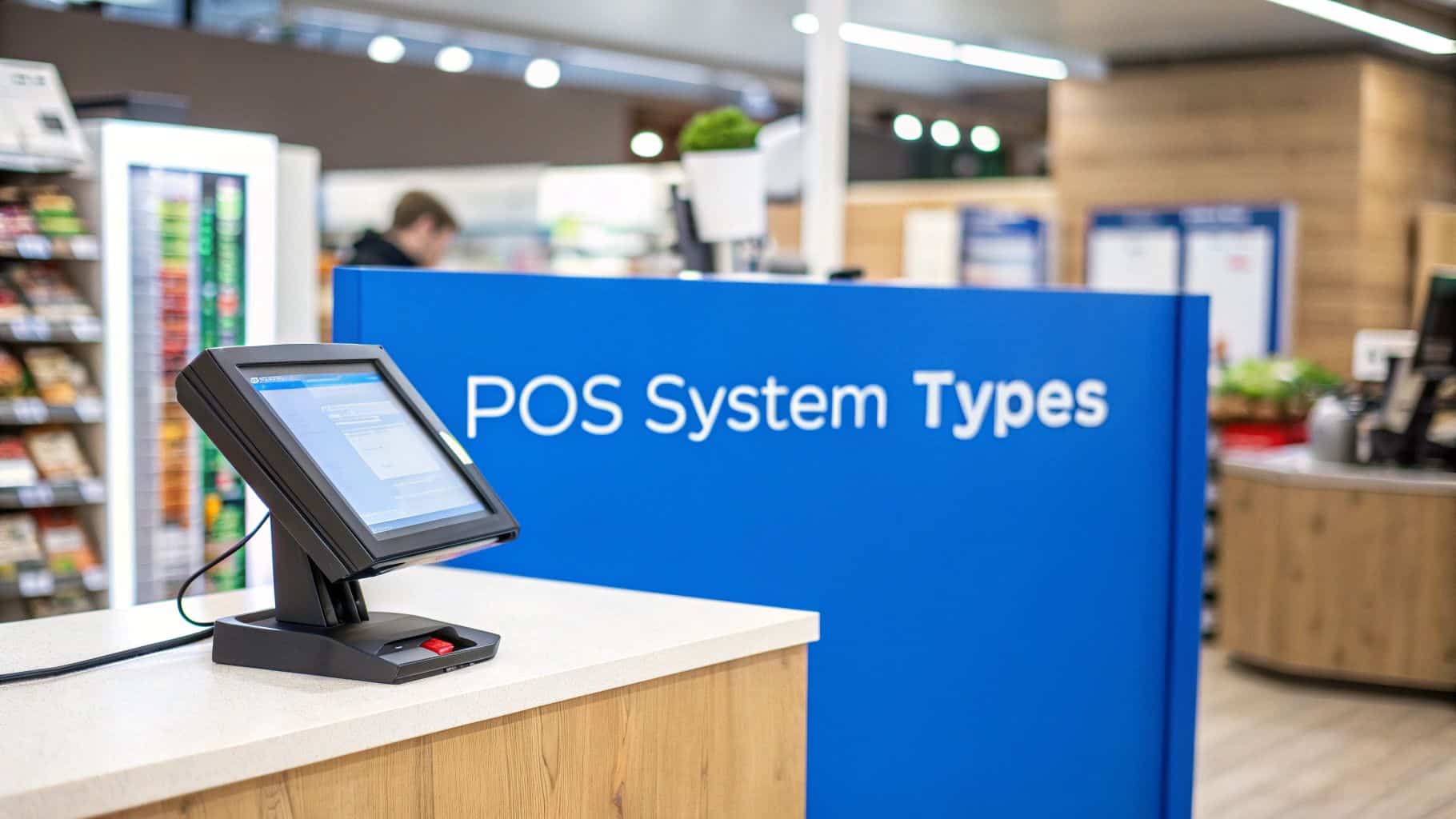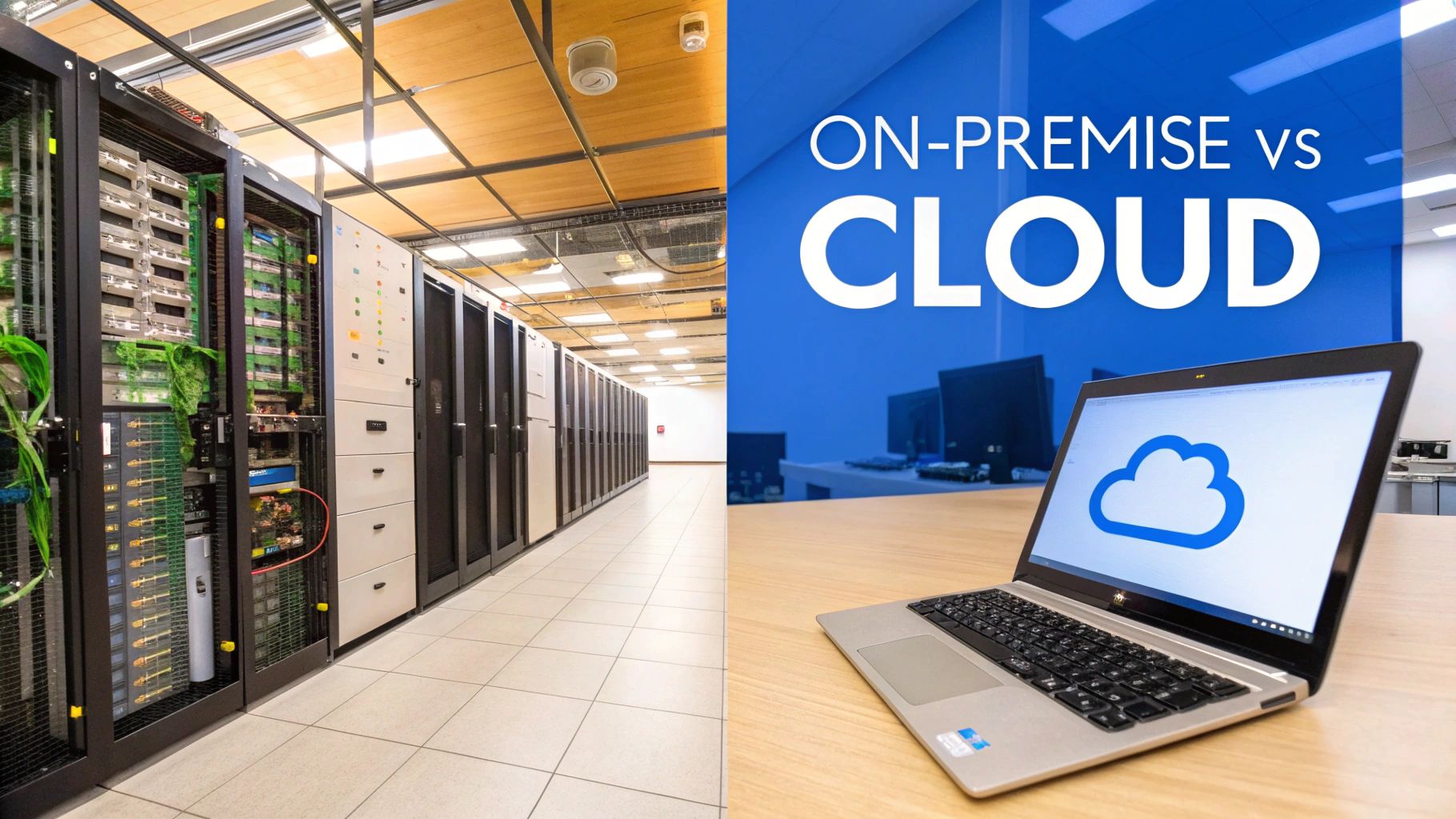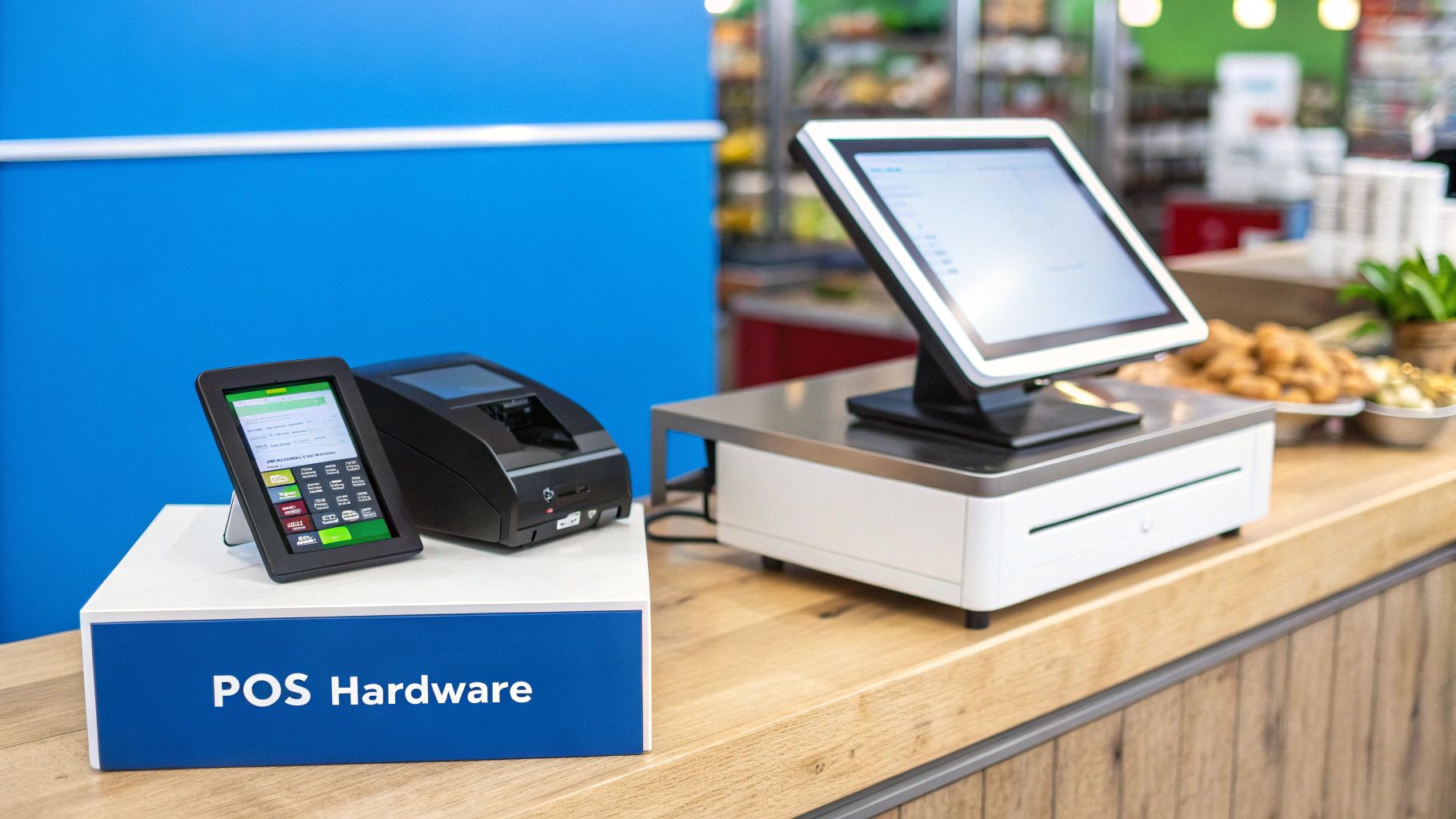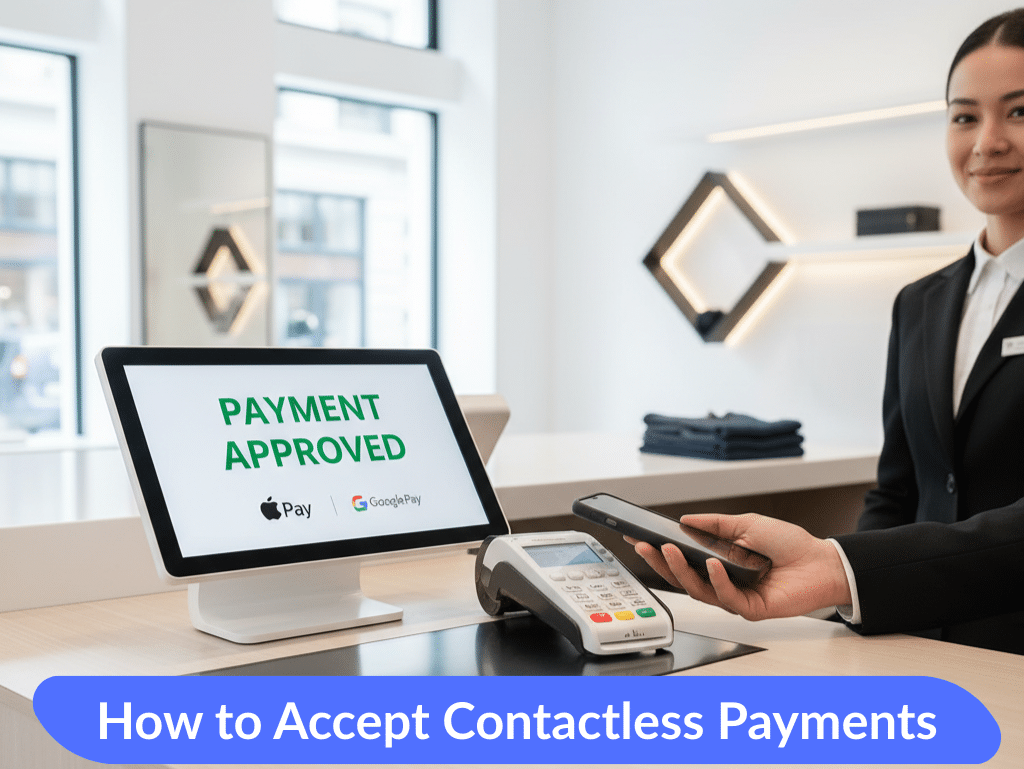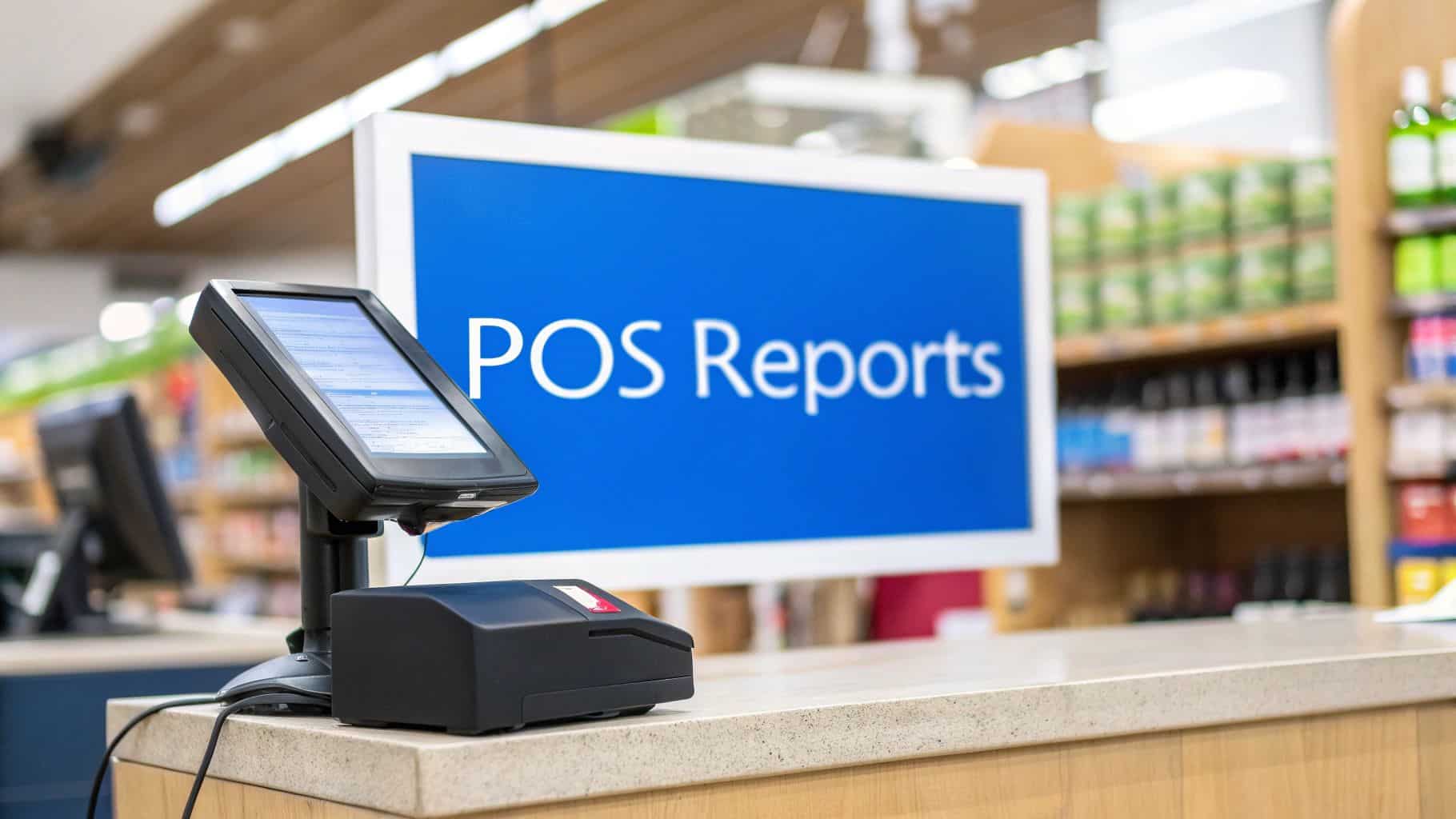A point of sale (POS) system is where everything comes together in your business—sales, inventory, and customer information. It’s so much more than a modern cash register; it’s the command center that processes transactions, keeps a running tally of your stock, and even offers a peek into your customers' buying habits. Choosing between the different types of point of sales systems is one of the most important decisions you'll make as a business owner.
What Exactly Is a Point of Sale System
Think of a POS system as the operational heart of your business. It's the mix of software and hardware that makes accepting payments and managing your daily grind feel effortless.
For a local coffee shop, it’s that sleek tablet that takes a customer's order, swipes their card, and zips the details over to the barista. In a big retail store, it's a whole network of terminals that track every single item sold and automatically adjust inventory numbers in real-time.
These systems have grown up a lot over the years. The global POS terminal market is expected to hit a staggering USD 181.47 billion by 2030, which just goes to show how essential they've become. This isn't just about traditional checkout counters anymore; it's about everything from fixed terminals to mobile solutions popping up in every industry. You can see more on these trends over at Grand View Research.
Core Functions and Business Benefits
At its heart, a POS system takes a bunch of complicated tasks and boils them down into simple, useful information. Its main jobs directly lead to real-world benefits that help your business run smoother and grow faster. The trick is to find a system whose functions perfectly match what you do every day.
This infographic does a great job of connecting the dots between a POS system's core roles and the direct perks your business gets.
As you can see, the system’s knack for handling transactions and inventory leads straight to a quicker checkout for your customers and spot-on stock counts for you, cutting down on costly mistakes.
Ultimately, a modern POS is a strategic partner. It automates the tedious but vital stuff, freeing you up to focus on what really matters: your customers and your growth. By pulling all your sales and inventory data into one place, it gives you the clarity you need to make smart calls on ordering, staffing, and marketing.
You can learn more by exploring our detailed guide on what a point of sale system is. Getting this foundation right will make it much easier to figure out which of the many options we're about to cover is the perfect fit for you.
On-Premise vs. Cloud-Based POS Software Models
When you start digging into the different types of point of sale systems, the first big question you have to answer is this: where will your software and data actually live? This single decision splits the POS world into two main camps—on-premise and cloud-based.
Each path offers a completely different way to manage your business, with its own unique set of perks and responsibilities.
The Traditional Powerhouse: On-Premise Systems
Think of an on-premise POS system like buying a house. You make a big upfront purchase for the property (the software license), and it all sits on your own land (a local server right there in your business). All your vital information, from sales history to customer details, is stored locally, giving you direct, physical control.
This model gives many business owners a strong sense of security and ownership. Since everything runs on your internal network, you can often keep ringing up sales even if the internet decides to take a coffee break.
The flip side, of course, is that you're the landlord. You're responsible for all the upkeep—installing software updates, running data backups, and troubleshooting any gremlins that pop up in the hardware or software.
For a long time, on-premise solutions were the only game in town, especially for larger, more established businesses. They do require a hefty initial investment in hardware and licenses, which can be tough for a new company to swallow. But after that one-time cost, you own the system outright.
Picture a big retailer with multiple locations and its own IT department. They'd likely lean towards an on-premise system. It gives them total command over data security and lets them tweak the software to fit their precise, complex needs. They've got the team and the resources to manage the local servers this setup requires.
The market still reflects this long history. In 2022, on-premise solutions made up USD 12.52 billion of the total USD 18.3 billion POS market.
The Flexible Alternative: Cloud-Based Systems
Now, let's look at the other side. A cloud-based POS system is more like renting a sleek, modern apartment in a fully-serviced building. Instead of a massive down payment, you pay a manageable monthly subscription fee. Your software and data are kept safe and sound on remote servers run by your provider—what we call "the cloud"—and you just tap into it over the internet.
This "Software as a Service" (SaaS) approach completely changes the financial picture, making it much easier to get started. Better yet, the provider handles all the backend headaches. Security patches, cool new features, and data backups are usually rolled out automatically, letting you focus on what you do best: running your business.
The real magic of a cloud-based system is its incredible accessibility and scalability. You can check sales reports, manage inventory, or see how things are going from any device, anywhere you have an internet connection—whether you're in the back office, at home, or on a beach.
Think about a nimble food truck or a brand-new boutique. A cloud-based system is a perfect match. The startup cost is low, and the system can grow right along with the business. If they decide to open a second shop, they just add another terminal to their subscription. No need to buy and set up a whole new server.
This blend of convenience and flexibility is why this model is taking off. By 2025, the cloud-based POS segment is expected to balloon to USD 8.82 billion. If this modern approach sounds interesting, you can dig deeper into what is a cloud-based POS system and how it all works.
To help you see the differences side-by-side, we've put together a simple comparison.
On-Premise vs Cloud-Based POS: A Feature Comparison
| Feature | On-Premise POS | Cloud-Based POS |
|---|---|---|
| Initial Cost | High: Requires upfront purchase of hardware and perpetual software licenses. | Low: Minimal upfront cost, based on a recurring monthly or annual subscription. |
| Data Storage | Local: Data is stored on a server located physically at your business. | Remote: Data is stored on the provider's secure servers ("the cloud"). |
| Internet Dependency | Low: Core transaction functions can often operate without an internet connection. | High: Requires a stable internet connection for full functionality. |
| Maintenance | Your Responsibility: You handle all software updates, security, and data backups. | Provider's Responsibility: The provider manages all backend maintenance automatically. |
| Accessibility | Limited: Access is generally restricted to your internal network. | High: Access your data and system from any device with an internet connection. |
| Scalability | Complex: Adding new locations or terminals requires significant hardware investment. | Easy: Simply add new users or devices to your subscription plan as you grow. |
Ultimately, deciding between an on-premise and a cloud-based model is the foundational first step. Your choice here will guide you toward the perfect type of point of sale system for your unique business needs.
Exploring POS Hardware and Form Factors
Once you've figured out the software side of things, it's time to think about the physical setup. The hardware is the tangible part of your POS system—it's what your staff will use all day and what your customers will interact with at checkout. Getting this right is crucial because it directly shapes how smooth and efficient your daily operations feel.
POS systems come in all shapes and sizes, from big, traditional registers to sleek tablets you can carry in one hand. Each design serves a different purpose and fits a specific type of business environment. Let's break down the most common options to see which one makes sense for you.
The Sturdy Workhorse: Terminal POS
When you picture a classic checkout counter, you're probably thinking of a terminal POS. This is the traditional setup you see in grocery stores and large retail shops—a dedicated computer, cash drawer, receipt printer, and barcode scanner all working in concert.
These systems are absolute workhorses, built to withstand the pressures of high-volume sales. They're stationary, incredibly reliable, and designed to handle thousands of transactions a day without breaking a sweat. While they aren't as portable as newer options, their raw power and stability make them the gold standard for businesses with dedicated checkout lanes.
The Rise of Mobile and Tablet POS Systems
On the other end of the spectrum, you have mobile POS (mPOS) and tablet POS systems. These setups have completely changed the game by turning everyday devices like iPads and smartphones into powerful payment processors. This has made sophisticated sales technology accessible to even the smallest businesses.
Think about a busy café where servers can take orders and payments right at the table, a vendor at a farmers' market, or a contractor taking a payment at a client’s house. This kind of flexibility is what mPOS is all about.
The core benefits are pretty clear:
- Lower Upfront Cost: You're using affordable, off-the-shelf hardware instead of specialized equipment.
- Better Customer Flow: Staff can check people out anywhere, which helps bust long lines and create a more personal experience.
- Total Portability: A must-have for any business on the move, from food trucks to craft fair booths.
Mobile and tablet systems untether you from the counter. This freedom allows you to build a more dynamic sales floor and interact with customers in a way that just wasn't possible before. It’s a game-changer for service speed and engagement.
Empowering Customers with Self-Service Kiosks
Another huge trend in the POS world is the self-service kiosk. These are standalone terminals that put the customer in the driver's seat, letting them place orders, customize their items, and pay—all without needing to talk to an employee. You’ve definitely seen them at fast-food restaurants, movie theaters, and even airports.
Kiosks are a fantastic tool for boosting efficiency and giving customers control over their experience. For the business, this means lower labor costs and faster service, especially during those crazy lunch rushes. By letting the kiosk handle the simple, repetitive orders, your team is freed up to tackle more complex customer needs or focus on making sure everyone has a great visit.
To get a better sense of the mechanics, our guide explains in detail how a self-service kiosk point of sale works.
Ultimately, the right hardware comes down to how your business operates day-to-day. A bustling clothing store has very different needs from a cozy coffee shop, and understanding your unique workflow is the key to choosing the perfect physical setup.
Finding a POS That Speaks Your Industry's Language
As you start looking at different point of sale systems, one thing becomes crystal clear: a one-size-fits-all POS just doesn't work. The day-to-day reality of a slammed restaurant is worlds apart from a trendy clothing boutique or a bustling hair salon. That's where industry-specific POS solutions come in—they're built from the ground up with these unique workflows in mind.
Trying to run a restaurant with a retail POS is like trying to build a house with only a hammer. You might get something standing, but it’s going to be a messy, inefficient process. A specialized system, on the other hand, gives you the complete toolkit your business needs to not just survive, but thrive.
POS Systems Built for Retail Success
In retail, inventory is king. A great retail POS system does way more than just count what you have in stock. It needs to handle the complex reality of modern inventory, like a single t-shirt that comes in 10 sizes and 15 colors.
Your system also has to bridge the gap between your physical storefront and your online shop. A few must-have features for any retailer include:
- Complex SKU Management: Easily keep track of every product variation—by size, color, material, you name it—to ensure your stock levels are always spot-on.
- Loyalty Program Integration: Build a loyal customer base by creating and managing rewards programs that give shoppers a real reason to come back.
- E-commerce Connection: Sync your inventory automatically between your brick-and-mortar store and your website to kill the risk of overselling an item you don't have.
This isn't just a "nice-to-have" feature set; it's a non-negotiable for any serious retailer. It turns your POS from a simple cash register into the command center for your entire business.
Essential POS Features for Restaurants
The restaurant world operates at a breakneck pace. Communication and timing are everything. A restaurant-specific POS is designed to handle this controlled chaos, keeping things running smoothly from the host stand to the kitchen line. Think about a busy Friday night—orders have to get to the kitchen instantly and without a single mistake.
A restaurant POS is the central nervous system connecting the dining room, bar, and kitchen. It streamlines communication, preventing the kind of errors and delays that can completely ruin a guest's experience.
Here are the core features every food service business needs:
- Table Mapping: Get a bird's-eye view of your dining room. A visual layout lets your host manage seating, servers can check table status, and you can optimize turnover to serve more guests.
- Order Modification: Handling special requests like "no onions" or "sauce on the side" becomes effortless. Modifiers are sent clearly to the kitchen, so the chefs know exactly what to do.
- Kitchen Display System (KDS) Integration: Orders are zapped directly to screens in the kitchen. This means no more lost paper tickets, fewer mistakes, and faster prep times.
These tools are what keep the peace and maintain harmony, even during the most hectic dinner rush.
Tailored Solutions for Service-Based Businesses
If you run a service business like a salon, spa, or auto repair shop, you're playing a completely different game. Your "inventory" is time and talent, which makes appointment management your most critical task. A generic POS just won't cut it.
Instead, service-based businesses need a system that can handle their unique needs with features like:
- Appointment Booking: A built-in calendar is essential for scheduling clients, managing staff availability, and sending out automated appointment reminders to reduce no-shows.
- Client History Management: Keep detailed records of every client—their past services, personal preferences, and purchase history—to deliver that personalized touch that keeps them coming back.
The huge growth in the U.S. point-of-sale market is being driven by businesses in retail and food service finally adopting these kinds of specialized, cloud-based systems. The major players are constantly innovating to meet these very specific industry demands. You can explore more about these market trends and who the key contributors are for a deeper dive.
How to Choose the Right POS System
Alright, so you know the different flavors of POS systems out there. Now comes the hard part: turning that knowledge into a confident decision for your business. Picking the right POS isn't just a technical choice; it's a strategic move that hinges on the unique rhythm of your daily operations and where you see your business heading.
This is more than just ticking boxes on a feature list. You're looking for a system that fits so well it feels like another member of your team. By taking a good, honest look at your needs, budget, and workflow, you can find a solution that does more than just ring up sales—it actually helps you grow.
Assess Your Unique Business Needs
Before you watch a single product demo or talk to a sales rep, you need to get crystal clear on your own operations. Every business has its own quirks. What’s a lifesaver for a bustling coffee shop will just get in the way at a bespoke clothing boutique.
Start by asking yourself some basic questions. How many transactions do you handle on an average day? Is your inventory a handful of items, or are you juggling hundreds of SKUs with variations like size, color, and material? It's also critical to think about where you're going.
Think about these key areas:
- Sales Volume: A business with lines out the door needs a lightning-fast, bulletproof terminal. On the other hand, a plumber making house calls will do just fine with a simple tablet setup.
- Inventory Complexity: Are you just tracking simple stock counts? Or do you need the ability to track product variants, manage ingredients for a restaurant, or bundle items together?
- Growth Plans: Do you have dreams of opening a second location, launching an online store, or adding a new service? Your POS needs to be ready to grow with you, not hold you back.
A good POS system solves your current problems without creating new ones down the road. Picking a system that fits your five-year plan ensures it remains a valuable tool, not a costly mistake you have to fix later.
Define Your Budget and Feature Priorities
Once you have a solid grasp of your needs, you can start mapping out a realistic budget and figuring out your "must-have" features. The sticker price of a POS is just the beginning. To avoid any nasty surprises, you have to account for all the costs involved.
Make sure your budget includes:
- Hardware Costs: This covers everything from terminals and tablets to cash drawers, receipt printers, and barcode scanners.
- Software Fees: Most modern systems have a monthly or annual subscription fee for the core software and any extra modules you need.
- Payment Processing: This is the slice of each transaction (a percentage or flat fee) that goes to the processor.
With your budget in mind, make two lists: non-negotiable features and "nice-to-haves." Your non-negotiables might be rock-solid inventory management and employee time clocks. The nice-to-haves could be things like a built-in customer loyalty program or a slick integration with your accounting software. This priority list becomes your North Star, keeping you focused on what really matters as you compare your options.
Got Questions About POS Systems? We’ve Got Answers.
Stepping into the world of point-of-sale technology can feel a bit overwhelming, and it's completely normal to have a lot of questions. As you start comparing software, hardware, and different setups, you need clear, straightforward answers. That's exactly what this section is for—to tackle the most common questions business owners ask about POS systems.
Think of this as your final checklist. We want to clear up any lingering confusion so you can feel confident in your decision and pick a solution that’s a perfect match for your business.
How Many Types of POS Systems Are There, Really?
While you'll find countless variations out there, most POS systems fall into one of about seven main categories. You've got your traditional terminal POS, the versatile tablet and mobile POS options, customer-facing self-service kiosks, and more specialized setups like online, multichannel, and open-source solutions.
Each type is built for a specific job. The right one for you depends entirely on how you operate—whether that’s a bustling retail shop, a food truck on the move, or a restaurant with multiple locations to manage.
What’s the Difference Between a POS System and a POS Terminal?
This is a great question, and it's a common point of confusion. Think of it like this: the POS terminal is the physical gear you see on the counter. It's the screen, the credit card reader, and the receipt printer where the transaction actually happens. It's a critical piece, but it's just one part of a bigger picture.
A POS system, on the other hand, is the whole shebang. It’s the hardware plus the intelligent software that runs the entire operation behind the scenes. That software is what handles your inventory, crunches your sales reports, keeps track of customer information, and manages employee access. The system is the brain; the terminal is just its hands and eyes.
Can a POS System Actually Work Without the Internet?
Yes, many of them can, and this is a game-changing feature. For any business where a spotty internet connection is a reality, having an "offline mode" is non-negotiable. Both modern cloud-based and on-premise systems often include this capability.
In offline mode, your system keeps ringing up sales and securely stores all the transaction data right there on the device. As soon as your internet comes back online, it automatically syncs everything back up to the cloud or your main server. Not a single sale is lost.
This feature is a crucial safety net. It means an internet outage won’t bring your business to a screeching halt, protecting both your customer experience and your revenue. For many businesses, it’s an absolute must-have.
Ready to find a POS system that simplifies your operations and helps your business grow? Biyo POS offers an all-in-one solution with features tailored for retail, restaurants, and service industries. Discover how our flexible, intuitive system can work for you. Start your free 14-day trial today
